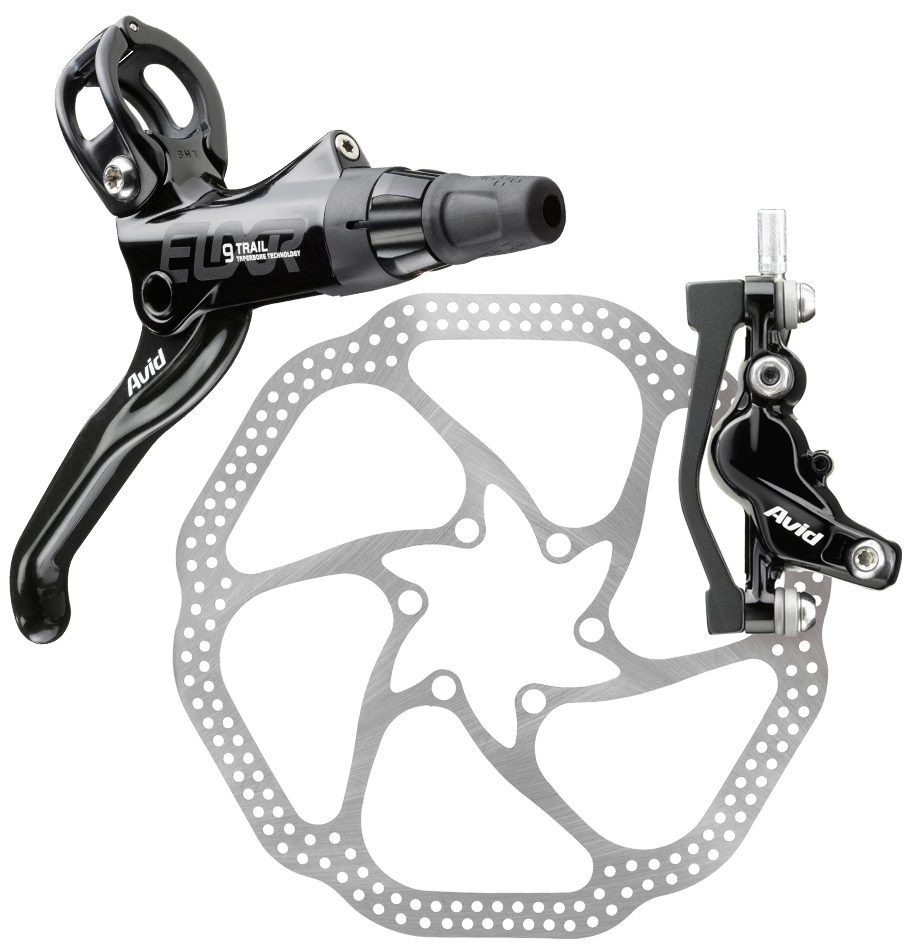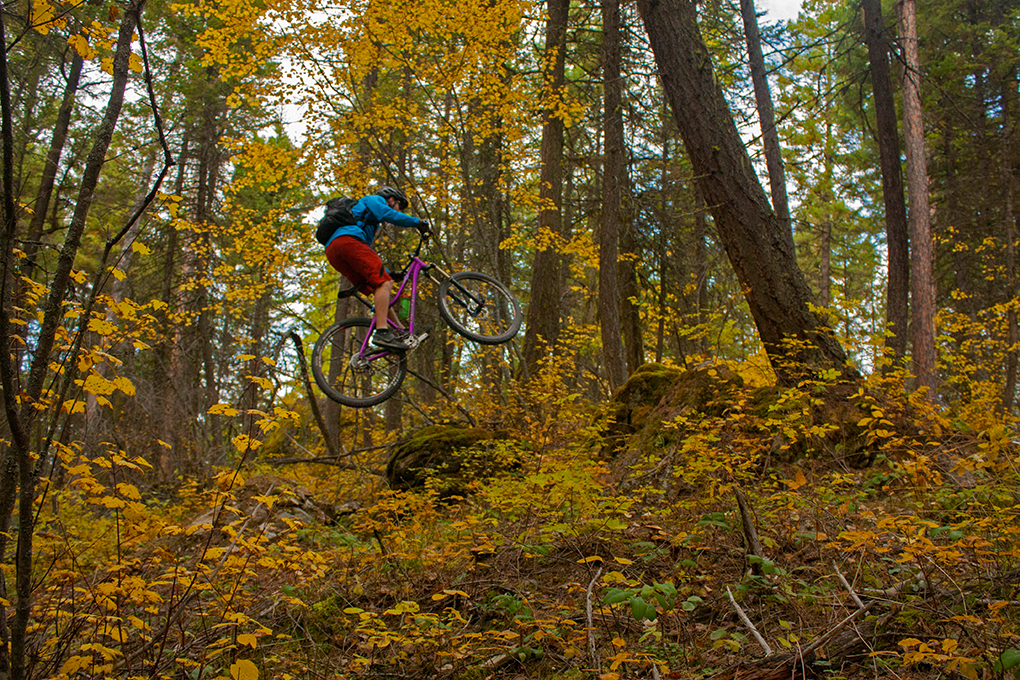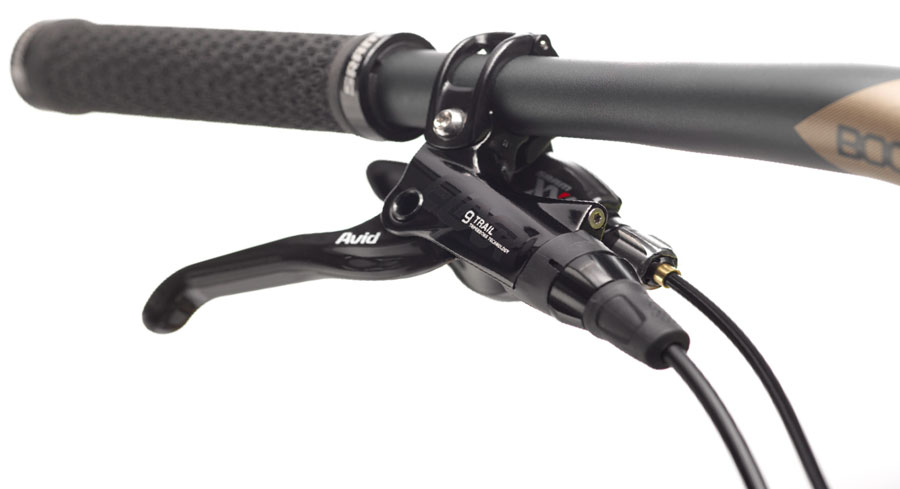
Avid Elixir 9 Trail Brakes
Intended use: Lightweight stopping power
Blister’s Measured Weights:
- Front with matchmaker clamp, 7” adapter and hardware: 275g
- Rear with matchmaker clamp, 7” adapter and hardware: 285g
- 7” rotors – 133g each
Bolted to: Canfield Yelli Screamy
Rider: 5’9”, 150 lbs.
Test locations: Around Whitefish, MT
Test Duration: ~30 rides
MSRP: $169 each
I’ve been riding Avid brakes for quite a few years now, and I think it will help if I give a little background covering my experience with them. In short, I generally like Avid brakes, but they have not been without their faults.
In my experience, Avids seem to need to be bled more often than some of the other options out there. Air seems to works its way into the system, usually at the lever end, which can result in spongy levers and unpredictable lever travel. Bleeding isn’t a horribly difficult process with the correct tools, but it’s still a hassle.
I also found that many Avid brakes were a bit low on power compared to some of the competition; they didn’t have the power that, for example, the newer Shimano’s offer.
But not all was bad. The Avid brakes always had excellent modulation. They struck an excellent balance between power and modulation, which meant that they worked well at almost any speed and in any condition. Where some brakes tended to feel grabby at low speeds, the Avids were always smooth.
I also like the shape of the Avid lever. Of course this is personal preference, but the lever is long enough to allow me to comfortably grab the brake with one finger no matter how I have my hands positioned on the bar.
All and all, Avid brakes are just what I’ve ended up with over the past few years, and honestly, the fact that I already had a bleed kit for Avid brakes meant I was resistant to trying out other brands. Yes, that’s an extremely lazy reason to stay dedicated to Avid, but now I think I have a stronger case to make for them.
The relatively new “trail” version of the Elixir 9 has a four-piston caliper, versus 2 pistons on the older models it replaces. This means the brakes have a wider pad and an increased contact patch with the caliper for more stopping power. It also means there’s a bit more material down there to help dissipate heat, which helps prevent fade on longer descents. And the new Elixir 9 Trails have seen these improvements while maintaining most of the attributes that I’ve liked about Avid’s brakes in the past.
Bleeding
The brakes came with an extra long rear hose which required a quick trim and bleed, and the bleeding process went smoothly and with minimal fuss. I got a good bleed on my first try, and everything has been running smoothly since. I haven’t had any issues with air bubbles developing, and the brakes even sat in my (unheated) garage over the winter with no ill effect.

A Brief Aside: DOT vs Mineral Oil
Avid and Avid brakes use DOT fluid. Some of the competition (Shimano) uses mineral oil. Which one is better? That’s a question that has sparked endless and somewhat pointless internet debate, but I’ll address it briefly.
DOT fluid is nasty stuff. It will take the paint off your bike and will probably give you about 18 different kinds of cancer in the state of California. DOT fluid is a standardized formula which meets certain specifications set by the Department of Transportation. DOT 5.1, which is commonly used in brakes, has a fairly high boiling point (meaning that you can get your brakes nice and hot before anything catastrophic happens).
Mineral oil is slightly less nasty and won’t take the paint off of your bike. It isn’t certified by any particular agency, though certain types of mineral oils certainly have defined specifications (it’s commonly used in hydraulic equipment, for example).
For use in bicycle brakes, it’s important to know that DOT and mineral oil are not interchangeable. The different fluids require different seals, and using the wrong type of fluid for your brakes is a good way to render the brake inoperable.
So which type of fluid is better suited for use in bicycle brakes? I’m fairly confident that the answer (1) depends on a bunch of variables that are beyond the scope of this review, and (2) depends on who you ask. So basically, I have no idea.
But I will say that I have a slight preference for using DOT fluid, mainly because it is incredibly easy to find. When you decide to bleed your brakes late at night when a race starts at 8:30 the next morning, only to find that you forgot to bring fluid, you’ll be a lot less stressed out. You can, as I have, walk into a gas station at midnight and grab a bottle of DOT fluid for about $3.
The Lever
The Elixir 9 Trails have essentially the same lever that Avid has been using for a few years, which I’m happy about. It has the same great shape, a tool-free reach adjust on the inside of the lever blade, and a pad contact adjustment where the hose comes out of the lever.

The reach adjust on these brakes works great and does exactly what I want it to do. The pad contact adjustment also works more or less as advertised, but I find that I almost always have it adjusted all the way in to give the lever the least amount of throw before pad contact.
The levers, like all Avid brakes, are matchmaker compatible, meaning they will mount up cleanly with Avid shifters and other Avid accessories like fork lockout levers and dropper post levers.
The levers are also ambidextrous, which is nice if you run yours reversed (motorcycle / euro style). No need to pull the hoses and re-bleed, just unbolt the levers and swap them.
The Ride
The Elixir 9 Trails maintain most of the features I’ve liked about Avid brakes in the past, but they improve upon some of the downsides. The most notable improvement is an increase in power, clearly attributable to the brakes’ redesigned 4 piston calipers.
And while there’s noticeably more power on tap with the Elixir 9 Trails, they still have the same modulation that made previous Avid brakes great. This is pretty important. There are plenty of brakes out there that are super powerful, and there are plenty of brakes that have great modulation. But there are relatively few brakes that are good at both. The Elixir 9 Trails, while not the most powerful brakes out there, provide respectable power with great modulation. There’s no question that when you need to haul yourself down from speed, the Elixir 9 Trails will get the job done more efficiently than the 2 piston stoppers of yore.

Like your review. Man, I need to come up and ride with you again. :)
On long descents, my XT brakes have significantly more power, which translates to less effort and less fatigue, and unlike my Avids (which I replaced), they don’t ever fade or fail completely. Availability of replacement fluid isn’t an issue on XTs because they don’t need regular bleeding. Subjective preference for lever feel and modulation characteristics can’t trump actual stopping performance and reliability can it?. When buying a complete bike you’re likely stuck with whatever deal the product manager has struck, but if buying/replacing brakes: would anyone seriously pick these over XTs?
I certainly don’t disagree that the XT’s are great brakes, but saying that XT’s don’t ever fade or fail is a bit of stretch. For example, you can refer to the well documented problem with XT’s in cold weather (a problem which I believe has been resolved).
Generally speaking, i think you’re right on the bleeding issue – historically Avids have required more frequent maintenance when compared to the current crop of Shimano offerings. Whether that will be the case for these newer Avids, I can’t say (yet). But for the record, the last minute bleed I referred to in the review wasn’t just a routine bleed to get rid of air or old oil – it was because I mangled the lever and had to replace it, and that’s not a scenario that’s unique to any specific brand.
Obviously anything like lever feel is going to be somewhat subjective. Whether that trumps performance? I guess that depends on how much I like or dislike the lever feel. There might be some brakes out there that offer outstanding power, modulation, and trouble free maintenance, but if I hate their lever I’m not going to buy them, regardless of how awesome they might otherwise be. I know some people who feel that way about the XT levers (and some that feel that way about the Avids).
My point to this long winded response: there is no across the board, one size fits all winner. Both are excellent brakes. If you have a strong preference one way or the other, by all means buy the one you like.
As someone who got my Moto Fly Ti 2014 with the new Trail 9 brakes, I couldn’t agree more with what you said. This was my first mtb in awhile and my first with hydraulic disks. I honestly thought I was getting the regular 9 brakes but was glad to see the upgrade as I had read negative feedback with the older models.
I think this really really has left a bad taste in consumers mouths so to say. I can’t really blame them.
Meanwhile Shimano puts out relatively trouble free products, consistently.
Perhaps it was a case of too little too late, and the decision to drop the Avid name altogether.
But from ALL the actual reviews on the Trail series brakes, I have yet to read a negative review. Personally, mine have operated awesomely the entire time and I have yet to change oil after a year. Tons of power but its the modulation that I really like for crawling down loose dirt faces or rock. Oh, I have had occasional squeal in pouring rain but its never been an “issue.”
Its kinda sad because they really got it right but Sram chose to start from scratch when they actually had a really good product. I would take my Trail 9s over the new Guides any day. I know they work.
hello. Is there any specific type of DOT fluid you need to use for these brakes?
I’ve used DOT 4 and 5.1 interchangeably. There are some differences between the two, but I haven’t found them to make any noticeable difference. My understanding is that DOT 3 also works fine, although I haven’t personally ever used it.
To the best of my knowledge, the only commonly available fluid that you DON’T want to use is DOT 5, which is silicone based, rather than glycone based. Using DOT 5 will likely do bad things to your brakes.